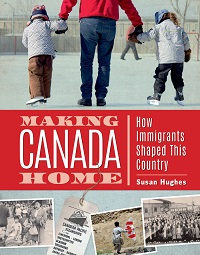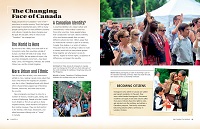| ________________
CM . . .
. Volume XXIII Number . . . .February 17, 2017
excerpt:
Making Canada Home is really a revised version of Hughes’ 2005 work, Coming to Canada. The contents have been restructured somewhat, but the text is very similar to the earlier volume with parts rewritten, updated, or left unchanged. She has updated some important terms and usage, for example, referring to the founding humans as Aboriginal peoples rather than Native peoples. In this instance, Hughes is already out of date as many organizations including the CBC and the Ontario Human Rights Commission are now using the term Indigenous peoples rather than Aboriginal peoples. Quibbling over usage is a dangerous undertaking since preferences will vary regionally, between sub groups and across different demographics. Nevertheless, it is curious that a writer from Toronto should use the term Indo Canadians to describe immigrants from India and nearby South Asian countries. Indo Canadian appears to be most commonly used in British Columbia, particularly in describing immigrants from the Punjab, while Ontarians are more likely to use the term South Asians.
The title of the book reflects the contents nicely. It is structured chronologically in the main, with an emphasis on waves of immigrants from specific countries or regions of the world. It begins with a chapter on Canada’s founding people and identified the first immigrants as the Aboriginal peoples. Hughes includes a couple of prevailing theories of human settlement of the America’s before describing the settlers from France, England and the American colonies following Britain’s recognition of the independence of the United States. The chapter includes topics one expects: the economic origins of settlement (fish, fur, agricultural land), the early Viking remains at L’Anse aux Meadows in NL, expulsion of the Acadians, the multi ethnic make up of the Loyalists (including members of the Six Nations Confederacy, Black loyalists, other European ancestries), the arrival of the Irish fleeing famine, and concludes with the impact upon the First Nations: broken promises, removal from the land, and the introduction of the residential school system. A strength of the work is Hughes’ celebration of Canada without ignoring its history of racist policies towards immigrants and ethnic Canadians alike. When it came to settling the vast prairies, preference was given to western European settlers; eastern Europeans were eventually welcomed. The early Chinese workers brought to Canada to help build the transcontinental railway through the rugged BC terrain were soon unwelcome and subject to head taxes and exclusionist policies. Chapter 3, “Closing the Doors”, discusses many of the efforts in the first half of the 20th century to promote a vision of Canada as a White, British land. Incidents recalled include the refusal to allow British subjects from India to disembark from the Komagatu Maru in 1914, the refusal to let Jewish refugees fleeing the Nazis to disembark from the S.S. St. Louis, and the internment of Canadians with Japanese, German and Italian heritage during periods when Canada was at war with their countries of origin. In the post-World War II period, Canada gradually became more welcoming to people from around the world. When Canada accepted 165,000 displaced people from Europe following the end of World War II, western Europeans were prioritized, particularly those with skills needed in Canada, and, importantly, community sponsorship. International humanitarian initiatives such as the creation of the Office of the United Nations High Commission for Refugees had an impact on countries like Canada. Refugees from Hungary, Tibet, Uganda, Vietnam, Afghanistan, and Syria have found haven in Canada, along with American draft dodgers. Hughes presents individual stories to contextualize the flight of refugees and their subsequent life in Canada. Hughes explores some of the changing values in Canadian society and the introduction of the point system in 1967 for assessing applicants that rapidly changed the face of Canada. Family reunification has accounted for about half of the immigrants since the 1970s as Canadians sponsor spouses, children, parents and grandparents. Hughes notes that the kaleidoscope of Canada is celebrated with cultural events, newspapers in many languages, and diverse religious practices. In the process of updating sections on the Afghan refugees, Hughes muddled the narrative, leaving in a statement about the estimated population of Afghan in 1979 and the numbers who left the country. The figures are misleading. Additionally, she describes the settlement of Afghan refugees into neighbourhoods known as “Little Kabuls”. This is not a very accurate depiction as my connections in the Afghan community claim that settlement is less concentrated than Hughes suggests, with Afghans often settling amongst other clusters of new Canadians. Additionally, it is simplistic to refer to all immigrants from a country as one group since ethnic differences and attitudes are such that there are really three distinct groups of Afghan immigrants to Canada. None live in neighbourhoods known as Little Kabul. Despite shortcomings, Making Canada Home is a good introduction to Canadian history focussing upon the people of the country and the lands from which they came. The kaleidoscope of Canada is truly an amazing accomplishment. That diverse peoples come together and live in relative peace and harmony is a tribute to humanity. However, Hughes missed the opportunity to reemphasize the scourge of racism that is lurking in our midst as expressed by politicians during the last federal election. As unpleasant as it may be, I would have liked further acknowledgement that some Canadians are afraid of immigrants, particularly those that seem different than themselves. Couching opposition to immigration in what Robin Sears calls the euphemistic term of “values” should be identified for what it really is: the latest iteration of discriminatory and even racist views directed against the other, the would be immigrant who hopes for a better life in Canada. I hope that teachers using this book can explore these matters more fully. Recommended. Val Ken Lem is a librarian at Ryerson University in Toronto, ON.
To comment
on this title or this review, send mail to cm@umanitoba.ca.
Copyright © the Manitoba Library Association. Reproduction for personal
use is permitted only if this copyright notice is maintained. Any
other reproduction is prohibited without permission.
Next Review | Table of Contents For This Issue - February 17, 2017 |

 Most of the abundant, appropriate and colourful photographs, illustrations and drawings are common to both volumes. Both include a timeline, an annotated list of further online resources, and a basic index. The present volume also has a brief glossary of limited value. It contains only 13 words or phrases and excludes many additional words from the text such as anthropologist and civil law that may be new to readers at the younger end of the target audience. Two additional features of the present volume are a brief description of major Canadian Immigration Laws, beginning with the Immigration Act, 1869 and continuing to the Strengthening Canadian Citizenship Act, 2014. Canada’s immigration statistics are nicely displayed in a series of colourful pie charts showing six regions of the world from which immigrants came in periods before 1971, 1971-80, 1981-90, 1991-2000, and 2001-2006. These are welcome features.
Most of the abundant, appropriate and colourful photographs, illustrations and drawings are common to both volumes. Both include a timeline, an annotated list of further online resources, and a basic index. The present volume also has a brief glossary of limited value. It contains only 13 words or phrases and excludes many additional words from the text such as anthropologist and civil law that may be new to readers at the younger end of the target audience. Two additional features of the present volume are a brief description of major Canadian Immigration Laws, beginning with the Immigration Act, 1869 and continuing to the Strengthening Canadian Citizenship Act, 2014. Canada’s immigration statistics are nicely displayed in a series of colourful pie charts showing six regions of the world from which immigrants came in periods before 1971, 1971-80, 1981-90, 1991-2000, and 2001-2006. These are welcome features.